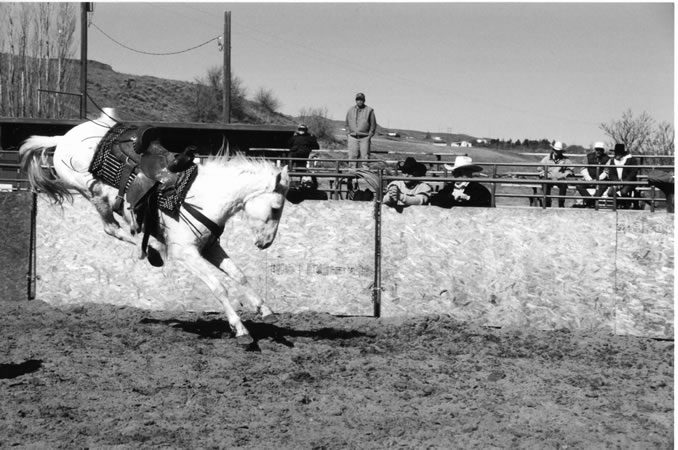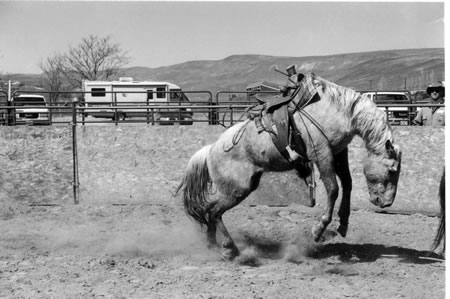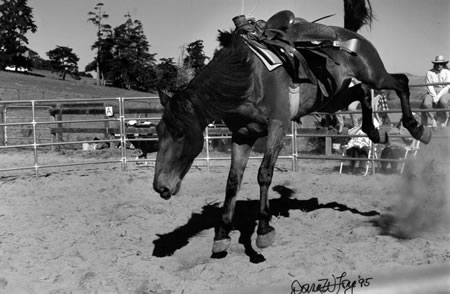Written by Bryan Neubert
This article originally appeared in Eclectic Horseman Issue No.31
If you’re spending much time trying to affect the behavior of horses, you are going to run into problems occasionally that seem difficult to solve. But when you do find the answer, it can change the way you do things from then on.
This story is about one of those. This was 1978 and I was just married and had a job in the Sierra Mountains taking care of a thousand cows on a grazing association. It was a straight riding job; there were no roads for vehicles. I had some horses of my own and I took on some outside horses as well.
One of these was a two-year-old palomino gelding belonging to a rancher. He was somewhat broke to lead and fairly gentle. When I turned him loose with my saddle for the first time, he bucked pretty hard and right into the fence and fell down. Most horses that fall down quit bucking and are quite a bit more careful how they handle themselves so it doesn’t happen again. This one didn’t. He poured it on just as hard or harder, but when he was done he didn’t buck again that day. But the next day was a repeat of the first and so on with the third and the fourth days.
Usually I would mount up on colts I started sooner than the fourth day, but he would get so upset when he bucked that he would ball and squeal and was so reckless. He was getting gentler every day, and when I did ride him on the fourth day, I remember feeling kind of ridiculous for waiting so long as he was very nice to ride. He was too young to use on my everyday work, so I shut him in every night to use in the mornings to gather my saddle horses, which were in a pasture that was about a mile long.
Every day he was getting handier, and was coming along nicely, except for the fact that he bucked everyday with my saddle. He quit bucking into the fence and never considered bucking with me. I kept thinking that he would clear up on that if he just had a job like many will, but it wasn’t happening. This was still going on into the third week and I was beginning to think that this was not going to look too good to the owner when he came to get him at the end of the month. but I just didn’t know what to do.
Finally, one Sunday morning, I was lying in bed contemplating my situation and I recalled a conversation I had with Ray Hunt in 1972.
He was talking to me about a horse he had called Hondo that bucked every saddling for a year until Tom Dorrance helped him and he never bucked again. Hondo’s problem was what brought these two men together in the first place. I remember asking Ray what all Tom did with Hondo. He told me several things, but one of them was that they would saddle him up and let him buck and as soon as he would smooth out, they would pull the saddle off and leave him alone.
Like my palomino, he would buck pretty hard, then he would be okay. Well then when they came back in about an hour, they would saddle him up, let him buck, pull the saddle off as soon as he was done. They would just repeat this all day. I remember telling Ray, “Looks to me like that would be rewarding him for bucking by pulling the saddle off whenever he was done,” and he explained to me that they were allowing Hondo an opportunity to work at what he thought he needed to do and by starting over every hour, he had a chance to practice the place where he had his problem.
I got up and couldn’t wait to try it. Being a Sunday, I could be around all day anyway. He bucked hard for 7 saddlings in a row, then on the eighth trip he thought about it and trotted off smooth. The next morning he trotted off pretty smooth and we were on our way.

He might have been pretty tired as he gave it 100% effort every trip. I started thinking about my college days when I got on quite a few bucking horses out of a chute. We practiced twice a week and there were quite a bunch of horses but only a handful of really nice horses that bucked smooth and straight and the same way every time. Everybody wanted to get on those good ones, but you had to speak up and reserve them as they only bucked them once or twice at the most a night. The good ones were good because they didn’t ever overdo it. Many people have seen the National Finals Rodeo on television. They’ll be bucking the best horses in the world, but never more than twice in ten days. I can think of nothing a horse can do to exert himself more in 10-15 seconds than bucking. It can be really hard work.
In the case of the palomino and Hondo, we allowed them to work hard, until they found out they didn’t need to buck anyway. Not long after I made it with the palomino, I got a call from Joe Wolter. His brother had a mare that had bucked everyday for about a week and I told him my story and told him to call me back. He called me back. He said he tried it and it worked really good; he just took right off.
It seems like about once a year someone would call me with the same horse. I would tell them that story and tell them to call me back. So far it hasn’t failed.
I have a friend at home that pastors a church and starts colts. His life has been nothing but starting colts and cowboying. He was telling me on the phone about a horse he had. He would warm him up good, and he wouldn’t buck with saddle. But he said, leaving the yard, he would buck with him everyday, but when he was done bucking, he would have his ears up and run right out and go help neighbors, move cattle, jump ditches and never would buck. He said, “I just don’t know what to do; he keeps dong this,” so I asked him, “Has he ever bucked you off?” and he said, “Never has, but he doesn’t fool around. He can buck.”
So I said, I would warm him up pretty good, get on him, ride him out of the yard and if he bucks, when he’s done, turn around and bring him back and unsaddle him. About every hour catch him again and repeat. He did that all one day and part of the next day. He said after that procedure he never bucked again. He said that he was pretty sore the next day (the man, not the horse). I know my friend, and if he tells me one can buck, then he can probably buck.
 Now, I’ve been talking about the cure, but what about the prevention? What about when you are starting? I’ve heard Ray say, “They just don’t know how not to.” When I was starting on the palomino in the corral and I would warm him up on the end of my rope, he’d be just fine. When I unbuckled that halter, his eyes would bug out and he could swell his lungs up with air and he’d be ready to buck. As he was getting gentler, I would saddle him up and lead him to the corrall, instead of saddling in the corral, and he looked nonchalant as could be, but when that halter came off, he would buck and crash into the fence. And I asked, “Well how come you can make it from the tack-room to this corral?”
Now, I’ve been talking about the cure, but what about the prevention? What about when you are starting? I’ve heard Ray say, “They just don’t know how not to.” When I was starting on the palomino in the corral and I would warm him up on the end of my rope, he’d be just fine. When I unbuckled that halter, his eyes would bug out and he could swell his lungs up with air and he’d be ready to buck. As he was getting gentler, I would saddle him up and lead him to the corrall, instead of saddling in the corral, and he looked nonchalant as could be, but when that halter came off, he would buck and crash into the fence. And I asked, “Well how come you can make it from the tack-room to this corral?”
 And then I realized that this was just something he thought he had to do. This is a pattern that I had allowed him to develop. So on horses since then, I might do some of the same, but I made this rule for myself. If they buck the first day, lots do that its a natural thing the creator puts in there for self-preservation. If they buck the second day, some will do that, too, but I keep track of those. On the third day, I have a long lead rope and a halter and I’ll go with them if they try to buck, I’ll get where they aren’t going to kick me and let them get started. Then I put that lead rope on my hip and stick their head right in their tail. If they’re one of those bigger, stronger ones that I can’t really stop, I’ll be horseback and dally and set them down, and that usually helps. I want to help them to learn that they want to go into that noseband with caution.
And then I realized that this was just something he thought he had to do. This is a pattern that I had allowed him to develop. So on horses since then, I might do some of the same, but I made this rule for myself. If they buck the first day, lots do that its a natural thing the creator puts in there for self-preservation. If they buck the second day, some will do that, too, but I keep track of those. On the third day, I have a long lead rope and a halter and I’ll go with them if they try to buck, I’ll get where they aren’t going to kick me and let them get started. Then I put that lead rope on my hip and stick their head right in their tail. If they’re one of those bigger, stronger ones that I can’t really stop, I’ll be horseback and dally and set them down, and that usually helps. I want to help them to learn that they want to go into that noseband with caution.
When my friend that I mentioned above told me about his horse, I told him a story about a roan mare I had that I brought back from Nevada. When I got to California, I was riding her and she wouldn’t buck with the saddle, but when I ‘d leave the yard, she would go about so far, get herself wadded up and threaten to tip over or buck. To remedy this as soon as she got loosened up, I would just bring her back and put her away. I called Tom and told him what the situation was and what I was doing, he said, “You’re gonna be fine,” and I was just fine. I did it several times in a day. I would saddle her up, warm her up, strike out, she’d loosen up and I would turn around and put her away and then start again in about an hour. In the case of a professional bucking horse, like I was explaining, that is something that we want them to keep. If you let everyone ride the good bucking horses, they’re going to quit bucking. It is extremely hard work and you don’t want to wear it out on them, but with one you want to live with, you do want to wear it out. Tom used to call it “beating them at their own game.”
Mercantile Purchases keep Eclectic Horseman Alive!
[ux_bestseller_products products=”” columns=”4″ title=”Check our bestsellers!”]


